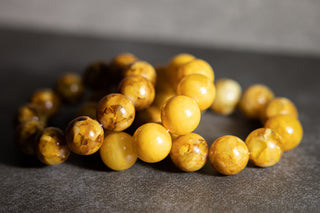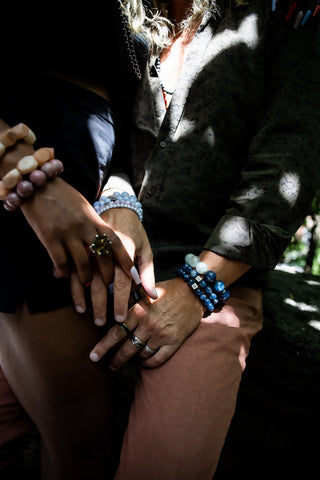If you are looking for a way to wear the history of nature literally, consider investing in jewelry made with Baltic amber.
1. What is Baltic Amber?
Baltic amber is an organic substance crafted from resin over 45 million years ago. Resin comes from pine trees. Today we use resin (sap) to make products like rosin, something applied to stringed instruments. But that is manufactured in the present.
Baltic amber is not.
Baltic amber is fossilized resin that was hardened millions of years ago and is crafted into beautiful pieces of jewelry today.

2. What is Baltic Amber made from?
Baltic amber is made from the resin or sap of pine trees. Chemically, it is a mixture of carbon, hydrogen, and oxygen and other 40 smaller chemicals like terpenes, organic acids, sodium, and iron.
3. Where can Baltic Amber be found?
Baltic amber comes from the Baltic area of Northern Europe around the Baltic Sea. This is where it gets its name. Throughout present-day Scandinavia, fossilized pine resin was exposed to oxidation and formed baltic amber, sometimes called the gold of the North.
4. What makes Baltic Amber so valuable?
Many factors contribute to the quality of Baltic amber and its value.
Contents
Baltic amber is effectively a fossil. It is fossilized organic material, the resin from pine trees. In some cases, baltic amber has genuine pieces of plants or insects inside. These plant or insect particles are legitimate fossils, representing a period of time before man.
Pieces of Baltic amber that contain fossilized insects or plants are much more expensive than clean pieces.
- Pieces of amber with insects or plants can be worth thousands of dollars.
- Pieces of amber without anything inside might be worth only a few dollars.
Clarity
Amber gives off beautiful opaque designs depending on how old it is and how it was fossilized. How clear a piece of amber is influences its value. This clarity can be altered in a laboratory setting with heat treatment, but the natural, untreated pieces fetch higher values.
- The more transparent it is, the more valuable it is.
Color
The color of the amber influences how valuable it is.
The level of oxidation and sun exposure dictates the color. Colors can change with time as increased oxidation and sun exposure happens. Baltic amber ranges in color from bright yellow to dark yellow to dark brownish orange, depending on how old it is and where it was found. In the smallest cases, Baltic amber pieces are opaque or transparent.
The color of Baltic amber can be modified with heat treatments.
- Reddish hues are more valuable than golden amber.
- Golden amber is more valuable than yellow amber.
Fun fact: When pieces of Baltic amber are cut or polished so that they can be made into jewelry, this removes or thins the harder exterior surface leaving the interior susceptible to increased oxidation. Pieces that were relatively translucent in yellow or orange can gradually darken into a deeper, reddish-brown.
Age
This leads to another aspect of its value: its age.
Baltic amber ranges in age from 45 million years ago to just a few million years ago, and how old the Baltic amber is dictates how opaque it is.
- As is the case with just about anything, the older something is, the more valuable it is.
Cut
The cut of Baltic amber influences the value. In most cases, the natural, freeform shape of the amber is simply polished and then set or drilled to make jewelry. In some cases, pieces are cut into beads or cabochons.
- Faceted amber is very rare and rated at a higher value.
5. Are there different types of amber? If so, what are they?

There are many types of amber preserved for millions of years in different areas around the world. Amber can be classified based on its color, its transparency, or where it was recovered.
Baltic Amber
Baltic amber is the most common type of amber found along the shores of the Baltic Sea. The forests in this area contributed to over 100,000 tons of amber, often rich with fossilized insect and plant pieces. Most baltic amber dates to 44 million years ago.
Black Amber
Black amber, sometimes called Oltu stone, comes from the Oltu town in the Erzurum Province in Turkey. It ranges in color from a dark brown to a jet black.
Blue Amber
Blue amber is very rare. It has primarily been found in the mountain ranges in the Dominican Republic.
Burmese Amber
Sometimes referred to by its age, Burmese amber was mainly found in Burma. A lot of Burmese amber contains pieces of the Cenomanian insect and is up to 99 million years old.
Copal
Copal comes from the copal tree: Protium Copal. Pre-Columbian Mesoamericans used this type of amber, who burned it with other items to create ceremonial incense. It is a particularly aromatic amber.
Green Amber
Green Amber is known for its special fragrance. Melted green amber is mixed with nitric acid to enhance the scent of pine trees. Green amber is usually a mixture of yellow and blue and can come from just about anywhere.
Caribbean Amber
Caribbean Amber comes from the Dominican Republic And Haiti. This is the only Caribbean island where amber has been found from the Hymenaea Protera Tree.
Mexican Amber
Mexican Amber comes from the Chiapas area of Mexico. It's about as old as most Dominican Amber. It is unique because it comes from the Hymenaea Mexicana tree, which is extinct. This tree is a relative of the Hymenaea Protera Tree, which produces Dominican amber.
6. Why is Baltic Amber so lightweight?
Baltic Amber is so lightweight because it is comprised almost entirely of hydrogen and oxygen. If you have ever held sap in your hands, you know that it's very lightweight, albeit sticky. This is the same substance just exposed to millions of years worth of oxidation.
7. What is the rarest type of amber?
This depends on what you value most. Technically blue amber is the rarest because so little of it has been found, and only in one area. However, larger pieces with complete plant or insect specimens are also valued for their rarity, depending on how large or rare the plant or insect is.
8. Does all amber have insects in it?
No, not all amber has an insect in it. Even amber that does contain insects usually has very small insects or pieces of an insect.
9. Why is Butterscotch Amber hard to find?
Butterscotch amber is the purest type of Baltic amber. Almost all amber is harvested by hand, which increases the labor cost. What's more, amber has to be shipped from its original location, which, in the case of butterscotch amber, is all the way from northern Europe.
It is hard to find because of the rare coloring. Butterscotch amber looks very similar to an egg yolk, with colors ranging from white to a bright, sunshine yellow. It's rare to find such bright colors as most Baltic Amber that is harvested along the Baltic Sea has more of a creamy yellow or golden hue.
The richer the color, the more expensive because richer colors come from increased oxidation which means older pieces of amber.
Fun fact: White varieties of butterscotch amber represent less than 2% of all the amber harvested in the world.
10. How to spot a fake Baltic Amber?
If you have invested in a piece of amber jewelry, you can easily verify whether it's legitimate by running an expensive and complicated test on the composition and verifying that it has succinic acid. Or you can use some very simple and fun tests at home.
Look at it.
First, look at it. A visual inspection is one of the easiest ways to spot a piece of fake baltic amber.
Legitimate amber usually has air bubbles. It is a piece of history, and as sap rows down a tree, it might collect insects or flakes from tree bark and plants, as well as air bubbles. So when you hold a piece of amber to the light, you should see natural imperfections.
Hold it.
Hold it in your hand. You should be suspicious of a seller who doesn't let you hold the Amber jewelry.
Because it comes from tree resin, real Baltic amber has a slightly tacky feel to it instead of that slick glass feel from other beads. It's somewhat warm to the touch as opposed to cold gemstones and feels very light. Most people are surprised at how lightweight it is.

Rub it.
This sounds weirder than it is.
Real amber has electrostatic properties, which means it can hold a charge. Think of it like shuffling across the carpet in socks. If you wrap your amber jewelry in a piece of cloth and rub it for about 45 seconds and hold it near your hair, it should make the hair rise.
Throw it in water.
Amber is unique in that it floats in salt water but sinks in fresh water. If you can, toss your amber in a container of salt water. Fake amber will sink.

